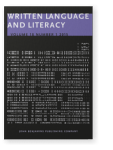From t-bias to d-bias in Dutch
Evidence from children’s spelling and pronunciation
Previous studies reveal that young Dutch children display a [t]-bias in the middle of words in pronunciation (e.g. van der Feest 2007; Kerkhoff 2007). First graders, however, display a 〈d〉-bias in the middle of words in their writings (Neijt & Schreuder 2007). The present study investigates children’s spelling and pronunciation of word medial d and t to examine this apparent contrast. It turned out that first graders started with a 〈t〉-bias in their spellings while later on they displayed a 〈d〉-bias. A similar development was found for pronunciation: Kindergartners displayed a [t]-bias, while second graders displayed a [d]-bias instead. Our explanation is that this change is caused by overgeneralization, due to differences between Dutch pronunciation and orthography. We conclude that the orthographic system, although learned later in life, affects children’s earlier acquired pronunciation.
References
Beers, Mieke
(
1995)
The phonology of normally developing and language-impaired children (Doctoral dissertation). Amsterdam: University of Amsterdam.
Boelhouwer, Bob
(
1998)
From letter strings to phonemes: The role of orthographic context in phonological recoding (Doctoral dissertation). Nijmegen: Radboud University Nijmegen.
Bosman, Anna M.T. & Guy C. van Orden
(
2003)
Het fonologisch coherentiemodel voor lezen en spellen [The phonologic coherence model of reading and spelling].
Pedagogische Studiën 801: 391–406.

Caravolas, Marketa, Charles Hulme & Margaret J. Snowling
(
2001)
The foundations of spelling ability: Evidence from a 3-year longitudinal study.
Journal of Memory and Language 451: 751–774.


Coltheart, Max, Kathleen Rastle, Conrad Perry, Robyn Langdon & Johannes Ziegler
(
2001)
DRC: A Dual Route Cascaded model of visual word recognition and reading aloud.
Psychological Review 1081: 204–256.


Dijkstra, Ton, Uli H. Frauenfelder & Robert Schreuder
(
1993)
Bidirectional grapheme-phoneme activation in a bimodal detection task.
Journal of Experimental Psychology: Human Perception and Performance 191: 931–950.


Ernestus, Mirjam & R. Harald Baayen
Ernestus, Mirjam & R. Harald Baayen
(
2003)
Predicting the unpredictable: interpreting neutralized segments in Dutch.
Language 791: 5–38.


Feest, Suzanne V.H. van der
Feest, Suzanne V.H. van der
(
2007)
Building a phonological lexicon: the acquisition of the Dutch voicing contrast in perception and production (Doctoral dissertation). Nijmegen: Radboud University Nijmegen.
Fikkert, Paula
(
2007)
Acquiring phonology. In
Paul de Lacy (ed.),
Handbook of phonological theory, 537–554. Cambridge, MA: Cambridge University Press.


Frisson, Steven & Dominiek Sandra
(
2002a)
Determinanten van werkwoordfouten in de Nederlandse spelling. Een experimenteel onderzoek bij jonge en ervaren spellers [Determinants of verb errors in Dutch spelling. An experimental study with young and experienced spellers].
Nederlandse taalkunde 71: 127–141.

Frisson, Steven & Dominiek Sandra
(
2002b)
Homophonic forms of regularly inflected verbs have their own orthographic representations: A developmental perspective on spelling errors.
Brain and Language 821: 545–554.


Gillis, Steven
(
2004)
Vroege taalverwerving [Early language acquisition]. In
Frans Daems (ed.),
Taal verwerven op school: taaldidactiek voor basisonderwijs en eerste graad secundair [
Acquiring language at school: Language didactics for primary education and first grade secondary school], 29–59. Leuven: Acco.

Gillis, Steven & Anne Marie Schaerlaekens
(
2000)
Kindertaalverwerving: een handboek voor het Nederlands [
Child language acquisition: a handbook for Dutch]. Groningen: Nijhoff.

Iverson, Gregory K. & Joseph C. Salmons
(
1995)
Aspiration and laryngeal representation in Germanic.
Phonology 121: 369–396.


Iverson, Gregory K. & Joseph C. Salmons
(
2003)
Legacy specification in the laryngeal phonology of Dutch.
Journal of Germanic Linguistics 151: 1–26.


Jakobson, Roman
(
1941/1968)
Kindersprache, Aphasie und allgemeine Lautgesetze/Child Language, aphasia and phonological universals. The Hague, Paris: Mouton.


Kager, René, Suzanne V.H. van der Feest, Paula Fikkert, Annemarie O. Kerkhoff & Tania S. Zamuner
Kerkhoff, Annemarie
(
2007)
Acquisition of morpho-phonology: The Dutch voicing alternation (Doctoral dissertation). Utrecht: LOT.
Kerkhoff, Annemarie, Elise de Bree & Hester A. Buesseler
(
2014)
Saying ‘t’ and writing ‘d’: Dutch children’s knowledge of voicing alternation in plurals. In
René Kager,
Janet Grijzenhout &
Koen Sebregts (eds.),
Where the principles fail. A festschrift for Wim Zonneveld on the occasion of his 64th birthday, 101–112. Utrecht: Utrecht Institute of Linguistics OTS.

Neijt, Anneke & Robert Schreuder
Notenboom, Annelise & Pieter Reitsma
(
2003)
Investigating the dimensions of spelling ability.
Educational and Psychological Measurement 631: 1039–1059.


Sandra, Dominiek, Steven Frisson & Frans Daems
(
1999)
Why simple verb forms can be so difficult to spell: The influence of homophone frequency and distance in Dutch.
Brain and Language 681: 277–283.


Schreiber, Peter A. & Charles Read
(
1980)
Children’s use of phonetic cues in spelling, parsing, and – maybe – reading.
Bulletin of the Orton Society 301: 209–224.


De Schryver, Johan, Anneke Neijt, Pol Ghesquière & Mirjam Ernestus
(
2008)
Analogy, frequency, and sound change. The case of Dutch devoicing.
Journal of Germanic Linguistics 201: 159–195.


De Schryver, Johan, Anneke Neijt, Pol Ghesquière & Mirjam Ernestus
Templeton, Shane & Darrell Morris
(
2000)
Spelling. In
Michael L. Kamil,
Peter Mosenthal,
P. David Pearson &
Rebecca Barr (eds.),
Handbook of reading research, 525–543. Mahwah, NJ: Lawrence Erlbaum.

Treiman, Rebecca & Derrick Bourassa
(
2000)
The development of spelling skill.
Topics in Language Disorders 201: 1–18.


Treiman, Rebecca, Marie Cassar & Andrea Zukowski
(
1994)
What types of linguistic information do children use in spelling? The case of flaps.
Child Development 651: 1310–1329.


Cited by
Cited by 2 other publications
Schmitz, Tijn, Robert Chamalaun & Mirjam Ernestus
Zuidema, Johan & Anneke Neijt
This list is based on CrossRef data as of 18 june 2024. Please note that it may not be complete. Sources presented here have been supplied by the respective publishers.
Any errors therein should be reported to them.
